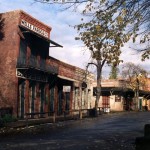Historic Towns
Tuolumne County is one of the smaller counties in California and is located right in the middle of the Gold County. The County was inhabited by the Mi-Wuk Indians until the Spanish came.
Then gold was discovered at Sutter’s Mill a week’s ride to the north (in 1848). Six months later, Americans reached the gold fields of Tuolumne County. The first American settlement was Wood’s Diggin’s, later changed to Wood’s Crossing and in the Spring of 1849 it became Jamestown. The next town was Sonora, just 3 miles away. It was already settled by Mexicans from Sonora, Mexico who called it Sonoran Camp, but the Americans changed the name to Sonora. Columbia, just a very few miles to the north was first called Hildreth’s Diggin’s but was later changed to Columbia.
Other towns sprang up all over Western Tuolumne County . . . anywhere someone found a piece of gold. Many of these towns, such as Campo Seco, are now no more than a whisper in the wind. Some, like Jacksonville are under several feet of water after the Hetch Hetchy project began in the early 1900s. Some towns barely survived such as Stent and Chinese Camp.
In 1897, the lumber industry discovered that Tuolumne County had trees in the higher elevation and more towns sprang up. Most of these survived and remained small such as Mi Wuk Village and Sugar Pine.
There are many small towns in The Great Unfenced and each of them have a story to tell.
Nearly half of the County is unsettled. The Stanislaus National Forest, the Sierra Nevada, and the Emigrant Wilderness occupy a major portion of the County.

Join our list to stay up to date on specials and events in Tuolumne County!


